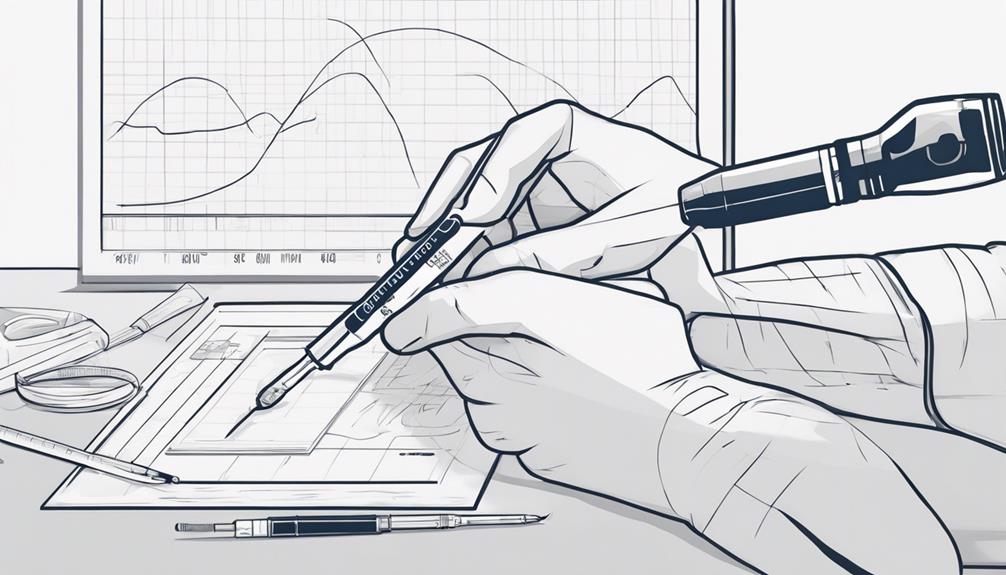Have you ever wondered why mastering insulin therapy is crucial for effectively managing type 1 diabetes?
Understanding the nuances of insulin dosing and timing can significantly impact your blood sugar control and overall well-being.
By exploring the various types of insulin available and learning how to fine-tune your administration techniques, you can navigate the complexities of insulin therapy with confidence.
Stay tuned to uncover essential strategies for monitoring blood sugar levels and safely adjusting insulin doses to optimize your diabetes management journey.
Key Takeaways
- Understanding insulin dosing and injection techniques is crucial for effective type 1 diabetes management.
- Utilizing insulin analogues and pumps allows for personalized blood sugar control strategies.
- Monitoring blood sugar levels through CGM systems and fingerstick tests aids in treatment adjustments.
- Safe insulin dose adjustments require precision, individualization, and close collaboration with healthcare providers.
Understanding Insulin Therapy Basics

To effectively manage your type 1 diabetes, comprehending the fundamental principles of insulin therapy is paramount. When it comes to insulin dosing, it's crucial to understand that the dosage requirements can vary based on factors such as your meal plan, activity level, and overall health. Your healthcare provider will work with you to determine the appropriate insulin dosage to maintain stable blood sugar levels throughout the day.
Injection sites play a vital role in insulin therapy. Rotating your injection sites is essential to prevent the development of lumps or skin changes that can affect insulin absorption. Common injection sites include the abdomen, thighs, buttocks, and upper arms. By rotating these sites, you can ensure that your body absorbs insulin consistently and effectively.
Understanding insulin dosing and proper injection site rotation are foundational aspects of managing your type 1 diabetes. By mastering these basics, you can take control of your insulin therapy and work towards achieving optimal blood sugar control.
Types of Insulin for Type 1 Diabetes
Different types of insulin are utilized in the management of type 1 diabetes to address varying needs and requirements of individuals. When considering insulin options for type 1 diabetes, two key categories are insulin analogues and insulin pumps.
- Insulin analogues: These are synthetic insulins designed to mimic the body's natural insulin production more closely than traditional human insulins. They can be rapid-acting, short-acting, intermediate-acting, or long-acting, providing more flexibility in dosing and timing to better match individual lifestyle needs.
- Insulin pumps: These devices deliver rapid-acting insulin continuously throughout the day via a catheter placed under the skin. They can also administer additional insulin as needed during meals or to correct high blood sugar levels. Insulin pumps offer precise insulin delivery, allowing for more stable blood sugar levels and greater flexibility in meal planning and physical activity.
Both insulin analogues and insulin pumps play crucial roles in the effective management of type 1 diabetes, offering individuals more personalized and efficient ways to control their blood sugar levels.
Insulin Administration Techniques

Insulin administration techniques are pivotal in effectively managing type 1 diabetes, ensuring precise delivery and control of insulin levels for optimal blood sugar regulation. Proper needle insertion plays a crucial role in the success of insulin therapy. When inserting the needle, it's essential to use a quick, smooth motion to minimize discomfort and tissue trauma. Rotating injection sites between different areas such as the abdomen, thighs, and buttocks helps prevent lipohypertrophy, a condition that can affect insulin absorption.
Understanding insulin absorption is key to achieving stable blood sugar levels. Factors like the depth of needle insertion, the angle at which the needle is inserted, and the injection speed can impact how quickly insulin is absorbed into the bloodstream. Injecting insulin into fatty tissue just below the skin allows for consistent absorption rates.
Monitoring Blood Sugar Levels
Effective monitoring of blood sugar levels is essential for managing type 1 diabetes and achieving optimal control of insulin therapy outcomes. To help you navigate this crucial aspect of diabetes management, consider the following key points:
- Continuous Glucose Monitoring (CGM): Utilizing CGM systems provides real-time data on your blood sugar levels, allowing you to track trends, identify patterns, and make informed decisions about your insulin therapy adjustments.
- Regular Self-Monitoring: Besides CGM, traditional blood glucose monitoring through fingerstick tests remains important for calibrating CGM devices, confirming accuracy, and ensuring precise insulin dosing.
- Integration with Insulin Pump Therapy: For individuals using insulin pump therapy, integrating CGM data with pump settings can enable automated insulin delivery adjustments based on real-time glucose readings, enhancing overall management and control.
Adjusting Insulin Doses Safely

When adjusting insulin doses safely for managing type 1 diabetes, precision in dosage calculation and regular monitoring of blood sugar levels are paramount. Insulin titration, a process of fine-tuning insulin doses to achieve optimal blood glucose control, plays a crucial role in diabetes management. Individualized dosing adjustments are key, as each person's insulin needs vary based on factors like diet, physical activity, stress levels, and illness.
To adjust insulin doses safely, it's essential to work closely with your healthcare team. They can help you determine the appropriate insulin titration strategy based on your unique needs and response to treatment. Regularly monitoring your blood sugar levels before and after meals, as well as throughout the day, will provide valuable data to guide insulin dose adjustments.
Frequently Asked Questions
How Can Stress and Other Emotional Factors Impact Insulin Therapy for Type 1 Diabetes?
When stress arises, your body's response can impact insulin therapy for type 1 diabetes. Emotional regulation plays a crucial role in managing these effects. Understanding how stress influences insulin needs and blood sugar levels is key.
Are There Any Alternative Insulin Delivery Methods Besides Injections for Type 1 Diabetes Patients?
You can explore alternative devices like implantable pumps, inhalable insulin, and patch technology as options besides injections for type 1 diabetes. These methods offer convenience and may enhance your insulin therapy experience.
What Role Does Physical Activity and Exercise Play in Managing Insulin Therapy for Type 1 Diabetes?
In managing insulin therapy for type 1 diabetes, physical activity and exercise are crucial. Regular exercise improves insulin sensitivity, helping balance blood sugar levels. Combining a healthy diet with a consistent exercise routine can optimize insulin management.
How Does Travel and Changes in Time Zones Affect Insulin Dosing for Individuals With Type 1 Diabetes?
When traveling across time zones, managing insulin dosing can be challenging due to jet lag. Adjusting your schedule gradually, monitoring blood sugar closely, and consulting with your healthcare team are crucial for maintaining diabetes control during these changes.
Can Certain Medications or Supplements Interact With Insulin Therapy and Affect Blood Sugar Levels in Type 1 Diabetes Patients?
Certain medications or dietary supplements can interact with insulin therapy, affecting blood sugar levels in type 1 diabetes patients. Alcohol consumption and caffeine intake may also influence insulin effectiveness. It's crucial to monitor these interactions for optimal diabetes management.
Conclusion
You have now mastered the art of insulin therapy for managing type 1 diabetes.
Just like a skilled conductor leading a symphony, you're in control of your blood sugar levels, knowing when to adjust insulin doses and how to monitor them effectively.
With this knowledge, you can navigate the complexities of diabetes management with precision and confidence, ensuring a harmonious balance in your health journey.